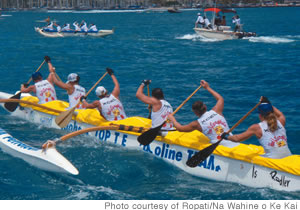Thirty Years Of Women Of The Sea

Wednesday - February 04, 2009
| Share
 Del.icio.us
Del.icio.us
|
Thirty years ago a group of women set out to prove the men wrong. They were tired of hearing the same message: “Women can’t do it.” They knew they were strong. They knew they were capable. They knew they could handle the treacherous Kaiwi Channel, too.
On Oct. 15, 1979, the women of the sea accomplished what many said could not be done: They conquered the channel. It was the date of the first women’s Molokai to Oahu Canoe Race.
“Thirty years, I never thought I would see this day,” says Na Wahine o Ke Kai race director Hannie Anderson. “The years have just flown by, and when I shut my eyes, the memories are just beautiful.”
The dream actually started in 1956, two years after the first men’s Molokai-to-Oahu Canoe Race. A crew from Waikiki Surf Club proposed a race across the channel for women. Coaches and race officials said no. The men said it was not safe.
“The women were driven,” recalls Anderson. “It took nearly 20 years to convince them, but we did.”
In October of 1975, the first unofficial crossing was made by two crews of 18 women each. Part of the dream was realized. Four years later, the dream was complete when 17 crews crossed the Kaiwi led by the women from Outrigger Canoe Club.
Anderson has been there every step of the way since.
“After all these years I still get emotional on race morning,” says Anderson. “I can see the women holding hands at Hale o Lono Harbor on Molokai and I see their smiles. There’s not a year that goes by that I don’t have a tear in my eye. This sport and this event have brought so many people together.”
On Sept. 27, 2009, women from all across the globe will come together again and celebrate 30 years.
But it won’t be easy. “This is our 30th year, and this may be our toughest because of the economy,” says Anderson. “Everything has tripled since last year. Our expenses have never been this high.”
Anderson says the cost to ship canoes to Molokai has gone up, and so have escort boat fees for race officials and medical staff. She estimates they spend about $25,000 just on official boats. She laughs, but reveals, “Even the price of the porta-potties has risen.
“The real cost for each crew to participate is about $1,300, but Na Wahine o Ke Kai only charged $550 in the past,” said Anderson. “This year the canoe clubs will be forced to absorb some of the expenses with higher fees. We want to keep it to a minimum, so that’s why we’re having this fundraiser.”
On Monday, Feb. 9, from 11:30 a.m. to 11 p.m., Formaggio Grill in Kailua will donate 10 percent of all bar and food purchases, including lunch, dinner and pupus.
“All they have to do is say they’re supporting Na Wahine o Ke Kai and the women benefit,” says a thrilled Anderson. “We are grateful Formaggio’s is doing this for us. We’re trying to reach out to as many people as possible.”
Anderson says the annual race is a positive for the sport and for women athletes. It’s also good for Molokai’s economy.
“The people of Molokai love when we come because we spend money,” chuckles Anderson. “Residents are so warm and welcoming. We’re always greeted with signs in Kaunakakai: Welcome, paddlers!”
Anderson understands economic struggles impact great events and knows securing sponsorships and financial support from the private sector will be a challenge.
“We do need help,” says Anderson. “We intend to continue this race for the women. We must continue.”
E-mail this story | Print this page | Comments (0) | Archive | RSS Comments (0) |
Most Recent Comment(s):













